Lia Morra
For a semiotic AI: Bridging computer vision and visual semiotics for computational observation of large scale facial image archives
Jul 03, 2024Abstract:Social networks are creating a digital world in which the cognitive, emotional, and pragmatic value of the imagery of human faces and bodies is arguably changing. However, researchers in the digital humanities are often ill-equipped to study these phenomena at scale. This work presents FRESCO (Face Representation in E-Societies through Computational Observation), a framework designed to explore the socio-cultural implications of images on social media platforms at scale. FRESCO deconstructs images into numerical and categorical variables using state-of-the-art computer vision techniques, aligning with the principles of visual semiotics. The framework analyzes images across three levels: the plastic level, encompassing fundamental visual features like lines and colors; the figurative level, representing specific entities or concepts; and the enunciation level, which focuses particularly on constructing the point of view of the spectator and observer. These levels are analyzed to discern deeper narrative layers within the imagery. Experimental validation confirms the reliability and utility of FRESCO, and we assess its consistency and precision across two public datasets. Subsequently, we introduce the FRESCO score, a metric derived from the framework's output that serves as a reliable measure of similarity in image content.
Toward a Realistic Benchmark for Out-of-Distribution Detection
Apr 16, 2024Abstract:Deep neural networks are increasingly used in a wide range of technologies and services, but remain highly susceptible to out-of-distribution (OOD) samples, that is, drawn from a different distribution than the original training set. A common approach to address this issue is to endow deep neural networks with the ability to detect OOD samples. Several benchmarks have been proposed to design and validate OOD detection techniques. However, many of them are based on far-OOD samples drawn from very different distributions, and thus lack the complexity needed to capture the nuances of real-world scenarios. In this work, we introduce a comprehensive benchmark for OOD detection, based on ImageNet and Places365, that assigns individual classes as in-distribution or out-of-distribution depending on the semantic similarity with the training set. Several techniques can be used to determine which classes should be considered in-distribution, yielding benchmarks with varying properties. Experimental results on different OOD detection techniques show how their measured efficacy depends on the selected benchmark and how confidence-based techniques may outperform classifier-based ones on near-OOD samples.
Latent Diffusion Models for Attribute-Preserving Image Anonymization
Mar 21, 2024Abstract:Generative techniques for image anonymization have great potential to generate datasets that protect the privacy of those depicted in the images, while achieving high data fidelity and utility. Existing methods have focused extensively on preserving facial attributes, but failed to embrace a more comprehensive perspective that considers the scene and background into the anonymization process. This paper presents, to the best of our knowledge, the first approach to image anonymization based on Latent Diffusion Models (LDMs). Every element of a scene is maintained to convey the same meaning, yet manipulated in a way that makes re-identification difficult. We propose two LDMs for this purpose: CAMOUFLaGE-Base exploits a combination of pre-trained ControlNets, and a new controlling mechanism designed to increase the distance between the real and anonymized images. CAMOFULaGE-Light is based on the Adapter technique, coupled with an encoding designed to efficiently represent the attributes of different persons in a scene. The former solution achieves superior performance on most metrics and benchmarks, while the latter cuts the inference time in half at the cost of fine-tuning a lightweight module. We show through extensive experimental comparison that the proposed method is competitive with the state-of-the-art concerning identity obfuscation whilst better preserving the original content of the image and tackling unresolved challenges that current solutions fail to address.
HOLMES: HOLonym-MEronym based Semantic inspection for Convolutional Image Classifiers
Mar 13, 2024Abstract:Convolutional Neural Networks (CNNs) are nowadays the model of choice in Computer Vision, thanks to their ability to automatize the feature extraction process in visual tasks. However, the knowledge acquired during training is fully subsymbolic, and hence difficult to understand and explain to end users. In this paper, we propose a new technique called HOLMES (HOLonym-MEronym based Semantic inspection) that decomposes a label into a set of related concepts, and provides component-level explanations for an image classification model. Specifically, HOLMES leverages ontologies, web scraping and transfer learning to automatically construct meronym (parts)-based detectors for a given holonym (class). Then, it produces heatmaps at the meronym level and finally, by probing the holonym CNN with occluded images, it highlights the importance of each part on the classification output. Compared to state-of-the-art saliency methods, HOLMES takes a step further and provides information about both where and what the holonym CNN is looking at, without relying on densely annotated datasets and without forcing concepts to be associated to single computational units. Extensive experimental evaluation on different categories of objects (animals, tools and vehicles) shows the feasibility of our approach. On average, HOLMES explanations include at least two meronyms, and the ablation of a single meronym roughly halves the holonym model confidence. The resulting heatmaps were quantitatively evaluated using the deletion/insertion/preservation curves. All metrics were comparable to those achieved by GradCAM, while offering the advantage of further decomposing the heatmap in human-understandable concepts, thus highlighting both the relevance of meronyms to object classification, as well as HOLMES ability to capture it. The code is available at https://github.com/FrancesC0de/HOLMES.
* This work has been accepted to be presented to The 1st World Conference on eXplainable Artificial Intelligence (xAI 2023), July 26-28, 2023 - Lisboa, Portugal
Fuzzy Logic Visual Network : A neuro-symbolic approach for visual features matching
Jul 29, 2023Abstract:Neuro-symbolic integration aims at harnessing the power of symbolic knowledge representation combined with the learning capabilities of deep neural networks. In particular, Logic Tensor Networks (LTNs) allow to incorporate background knowledge in the form of logical axioms by grounding a first order logic language as differentiable operations between real tensors. Yet, few studies have investigated the potential benefits of this approach to improve zero-shot learning (ZSL) classification. In this study, we present the Fuzzy Logic Visual Network (FLVN) that formulates the task of learning a visual-semantic embedding space within a neuro-symbolic LTN framework. FLVN incorporates prior knowledge in the form of class hierarchies (classes and macro-classes) along with robust high-level inductive biases. The latter allow, for instance, to handle exceptions in class-level attributes, and to enforce similarity between images of the same class, preventing premature overfitting to seen classes and improving overall performance. FLVN reaches state of the art performance on the Generalized ZSL (GZSL) benchmarks AWA2 and CUB, improving by 1.3% and 3%, respectively. Overall, it achieves competitive performance to recent ZSL methods with less computational overhead. FLVN is available at https://gitlab.com/grains2/flvn.
Bent & Broken Bicycles: Leveraging synthetic data for damaged object re-identification
Apr 16, 2023Abstract:Instance-level object re-identification is a fundamental computer vision task, with applications from image retrieval to intelligent monitoring and fraud detection. In this work, we propose the novel task of damaged object re-identification, which aims at distinguishing changes in visual appearance due to deformations or missing parts from subtle intra-class variations. To explore this task, we leverage the power of computer-generated imagery to create, in a semi-automatic fashion, high-quality synthetic images of the same bike before and after a damage occurs. The resulting dataset, Bent & Broken Bicycles (BBBicycles), contains 39,200 images and 2,800 unique bike instances spanning 20 different bike models. As a baseline for this task, we propose TransReI3D, a multi-task, transformer-based deep network unifying damage detection (framed as a multi-label classification task) with object re-identification. The BBBicycles dataset is available at https://huggingface.co/datasets/GrainsPolito/BBBicycles
PROTOtypical Logic Tensor Networks (PROTO-LTN) for Zero Shot Learning
Jun 26, 2022



Abstract:Semantic image interpretation can vastly benefit from approaches that combine sub-symbolic distributed representation learning with the capability to reason at a higher level of abstraction. Logic Tensor Networks (LTNs) are a class of neuro-symbolic systems based on a differentiable, first-order logic grounded into a deep neural network. LTNs replace the classical concept of training set with a knowledge base of fuzzy logical axioms. By defining a set of differentiable operators to approximate the role of connectives, predicates, functions and quantifiers, a loss function is automatically specified so that LTNs can learn to satisfy the knowledge base. We focus here on the subsumption or \texttt{isOfClass} predicate, which is fundamental to encode most semantic image interpretation tasks. Unlike conventional LTNs, which rely on a separate predicate for each class (e.g., dog, cat), each with its own set of learnable weights, we propose a common \texttt{isOfClass} predicate, whose level of truth is a function of the distance between an object embedding and the corresponding class prototype. The PROTOtypical Logic Tensor Networks (PROTO-LTN) extend the current formulation by grounding abstract concepts as parametrized class prototypes in a high-dimensional embedding space, while reducing the number of parameters required to ground the knowledge base. We show how this architecture can be effectively trained in the few and zero-shot learning scenarios. Experiments on Generalized Zero Shot Learning benchmarks validate the proposed implementation as a competitive alternative to traditional embedding-based approaches. The proposed formulation opens up new opportunities in zero shot learning settings, as the LTN formalism allows to integrate background knowledge in the form of logical axioms to compensate for the lack of labelled examples.
Faster-LTN: a neuro-symbolic, end-to-end object detection architecture
Jul 05, 2021


Abstract:The detection of semantic relationships between objects represented in an image is one of the fundamental challenges in image interpretation. Neural-Symbolic techniques, such as Logic Tensor Networks (LTNs), allow the combination of semantic knowledge representation and reasoning with the ability to efficiently learn from examples typical of neural networks. We here propose Faster-LTN, an object detector composed of a convolutional backbone and an LTN. To the best of our knowledge, this is the first attempt to combine both frameworks in an end-to-end training setting. This architecture is trained by optimizing a grounded theory which combines labelled examples with prior knowledge, in the form of logical axioms. Experimental comparisons show competitive performance with respect to the traditional Faster R-CNN architecture.
Breast Mass Detection with Faster R-CNN: On the Feasibility of Learning from Noisy Annotations
Apr 25, 2021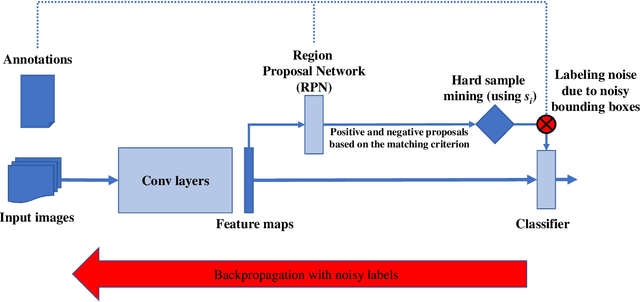

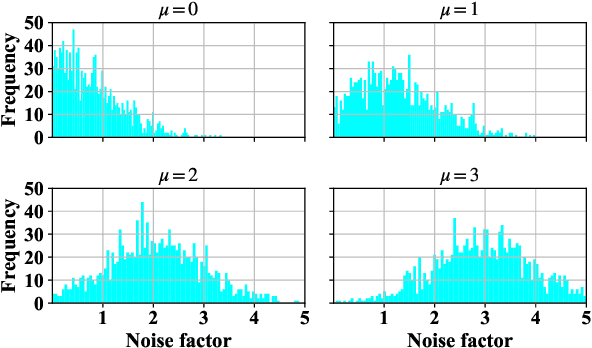
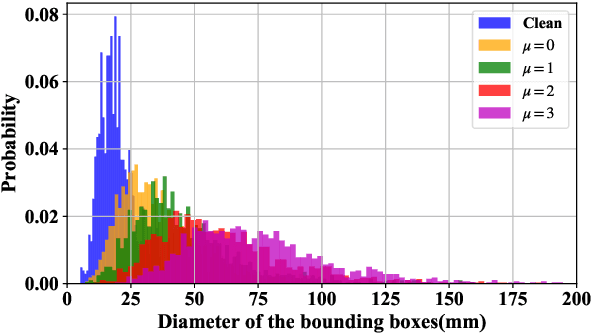
Abstract:In this work we study the impact of noise on the training of object detection networks for the medical domain, and how it can be mitigated by improving the training procedure. Annotating large medical datasets for training data-hungry deep learning models is expensive and time consuming. Leveraging information that is already collected in clinical practice, in the form of text reports, bookmarks or lesion measurements would substantially reduce this cost. Obtaining precise lesion bounding boxes through automatic mining procedures, however, is difficult. We provide here a quantitative evaluation of the effect of bounding box coordinate noise on the performance of Faster R-CNN object detection networks for breast mass detection. Varying degrees of noise are simulated by randomly modifying the bounding boxes: in our experiments, bounding boxes could be enlarged up to six times the original size. The noise is injected in the CBIS-DDSM collection, a well curated public mammography dataset for which accurate lesion location is available. We show how, due to an imperfect matching between the ground truth and the network bounding box proposals, the noise is propagated during training and reduces the ability of the network to correctly classify lesions from background. When using the standard Intersection over Union criterion, the area under the FROC curve decreases by up to 9%. A novel matching criterion is proposed to improve tolerance to noise.
Comparing State-of-the-Art and Emerging Augmented Reality Interfaces for Autonomous Vehicle-to-Pedestrian Communication
Feb 04, 2021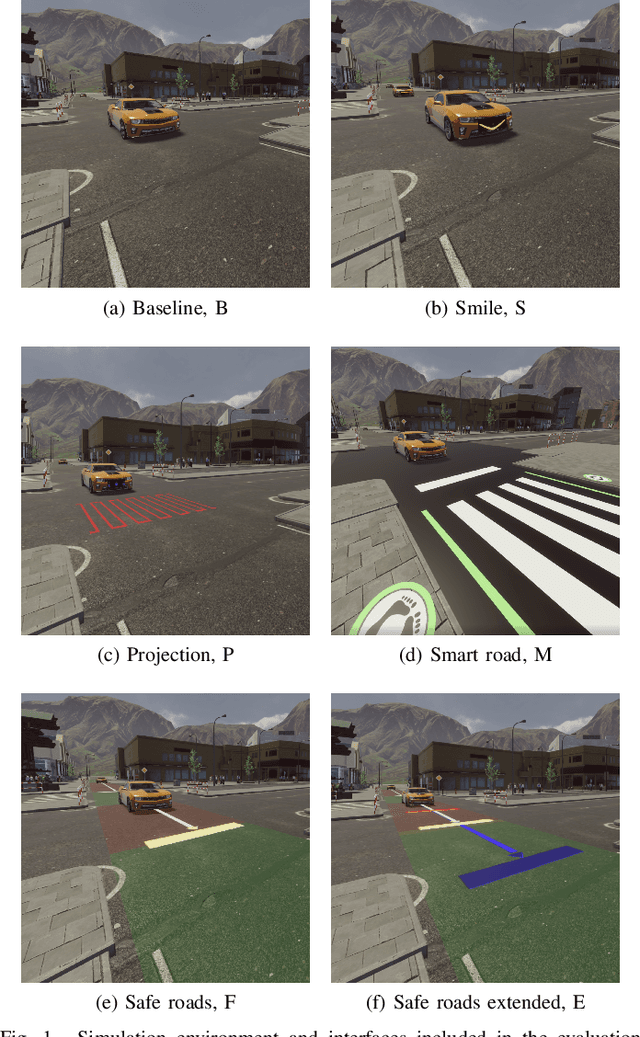

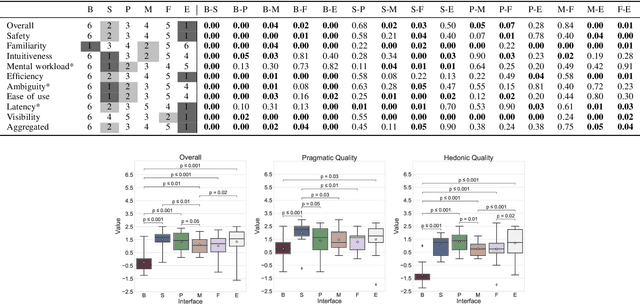

Abstract:Providing pedestrians and other vulnerable road users with a clear indication about a fully autonomous vehicle status and intentions is crucial to make them coexist. In the last few years, a variety of external interfaces have been proposed, leveraging different paradigms and technologies including vehicle-mounted devices (like LED panels), short-range on-road projections, and road infrastructure interfaces (e.g., special asphalts with embedded displays). These designs were experimented in different settings, using mockups, specially prepared vehicles, or virtual environments, with heterogeneous evaluation metrics. Promising interfaces based on Augmented Reality (AR) have been proposed too, but their usability and effectiveness have not been tested yet. This paper aims to complement such body of literature by presenting a comparison of state-of-the-art interfaces and new designs under common conditions. To this aim, an immersive Virtual Reality-based simulation was developed, recreating a well-known scenario represented by pedestrians crossing in urban environments under non-regulated conditions. A user study was then performed to investigate the various dimensions of vehicle-to-pedestrian interaction leveraging objective and subjective metrics. Even though no interface clearly stood out over all the considered dimensions, one of the AR designs achieved state-of-the-art results in terms of safety and trust, at the cost of higher cognitive effort and lower intuitiveness compared to LED panels showing anthropomorphic features. Together with rankings on the various dimensions, indications about advantages and drawbacks of the various alternatives that emerged from this study could provide important information for next developments in the field.
 Add to Chrome
Add to Chrome Add to Firefox
Add to Firefox Add to Edge
Add to Edge